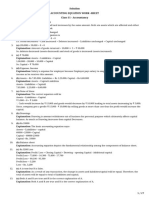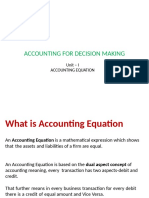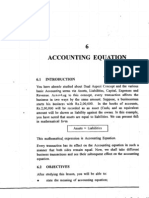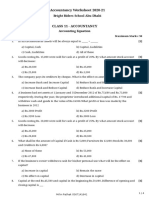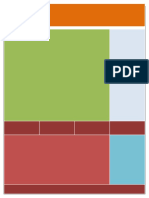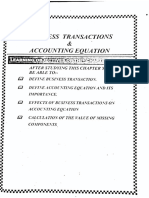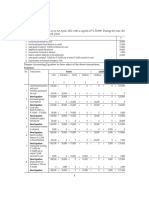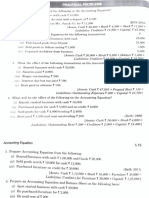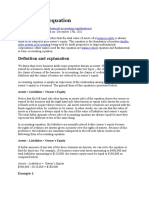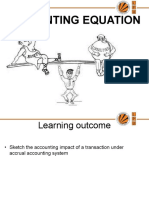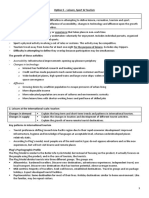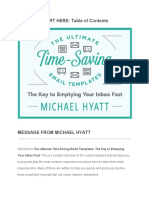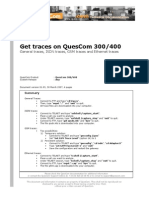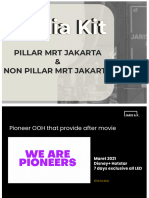Solution
Class 11 - Accountancy
Test 3
Section A
1. (b) Rs.25000
Explanation: Sale amount = Cost + Profit
Sale = 200000+ 25℅ of Cost
sale = 200000+50000
Sale = 250000
All sale is in cash. So Cash Balance will increase by Rs. 250000.
2. (a) Rs.4500 loss
Explanation: Profit/loss= Capital at end + drawings - capital at the beginning- Additional capital
Since there is no drawing and Additional capital ,so
Profit/loss = Capital at end- capital at beginning
Profit/loss= 45500- 50000
Profit/loss =-4500 Rs.
Hence there is Loss of 4500rs.
3. (d) Assets = Capital + Liabilities
Explanation: This equation is the base of accounting. This shows that the assets of the business is always equal to
liability and capital .
4. (b) Drawings
Explanation: Drawing is amount withdrawn out of business for personal purpose which ultimately affects capital
balance. As much as Drawing increases then capital Decreases.
5. (c) Reduce
Explanation: when we made payment of expense it will reduce business cash or bank balance which is an asset. So,
This will reduce Business Assets.
6. (d) Expense, Income
Explanation: Salary is expense for employer because Employer pays salary to employee and For Employee it will an
income as he receives this amount.
7. (b) Factory owned by the company
Explanation: Assets are the property of a business in its name. So factory owned by company is example of assets
8. (c) Decrease by Rs.5000
Explanation: If liability decrease by 5000 this means there is a payment for any liability which means cash outflow .
Cash is an assets which get decreases when we pay liability which means assets also decreases with same amount.
9. Cash = Total Assets - Other Sundry Assets
or = Capital + Liabilities - Other Sundry Assets
= 10,000 + 5,000 - 10,000
= Rs. 5000
10. Goods taken by the proprietor for personal use. Based on the double-entry system, the accounting equation ensures that
the balance sheet remains “balanced,” and each entry made on the debit side should have a corresponding entry.
11. No, any transaction can only change the equation but can't break it. The Accounting equation remains equal.
12. Cash and capital increases. A service is an intangible product, and income derived from selling your services must be
recorded in the accounting ledger.
13. It will result in cash being reduced and machinery account being increased. Based on the double-entry system, the
accounting equation ensures that the balance sheet remains “balanced,” and each entry made on the debit side should
have a corresponding entry (or coverage) on the credit side.
14. The accounting equation is considered to be the foundation of the double-entry accounting system. The total of all the
assets of a business should be equal to the total of all its liabilities in the balance sheet.The two basic purposes of an
accounting equation are:
i. As the accounting equation is always equal, it ensures the accuracy in recording the business transaction.
ii. It helps in the preparation of balance sheet.
15. The accounting equation is considered to be the foundation of the double-entry accounting system. The total of all the
assets of a business should be equal to the total of all its liabilities in the balance sheet. Based on this double-entry
system, the accounting equation ensures that the balance sheet remains “balanced,” and each entry made on the debit
side should have a corresponding entry (or coverage) on the credit side.
1/7
RKG EDUCATION PVT LTD venture by CA PARAG GUPTA
� Accounting equation
Transaction Assets = Liabilties + Capital
Cash + Stock + Debtors + Furniture = Creditors + Capital
(i) Harsha started business with cash 2,00,000 + 0 + 0 + 0 = 0 + 2,00,000
New equation 2,00,000 + 0 + 0 + 0 = 0 + 2,00,000
(ii) Purchased goods from Naman for cash (40,000) + 40,000 + 0 + 0 = 0 + 0
New equation 1,60,000 + 40,000 + 0 + 0 = 0 + 2,00,000
(iii) Sold goods to Bhanu costing Rs 10,000 0 + (10,000) + 12,000 + 0 = 0 + 2,000
New Equation 1,60,000 + 30,000 + 12,000 + 0 = 0 + 2,02,000
(iv) Bought furniture on credit 0 + 0 + 0 + 7,000 = 7,000 + 0
Final equation 1,60,000 + 30,000 + 12,000 + 7,000 = 7,000 + 2,02,000
16. The accounting equation is considered to be the foundation of the double-entry accounting system. The total of all the
assets of a business should be equal to the total of all its liabilities in the balance sheet. Based on this double-entry
system, the accounting equation ensures that the balance sheet remains “balanced,” and each entry made on the debit
side should have a corresponding entry (or coverage) on the credit side.
Accounting equation
Transaction Assets = Liabilties + Capital
Cash + Stock + Debtors + Furniture = Creditors + Capital
(i) Started business with cash Rs 1,00,000 and
1,00,000 + 40,000 + 0 + 0 = 0 + 1,40,000
goods Rs 40,000
New equation 1,00,000 + 40,000 + 0 + 0 = 0 + 1,40,000
(ii) Bought goods or cash Rs 30,000 and on
(30,000) + 50,000 + 0 + 0 = 20,000 + 0
credit for Rs 20,000.
New equation 70,000 + 90,000 + 0 + 0 = 20,000 + 1,40,000
(iii)Goods costing Rs 48,000 sold at a profit of
32,000 + (48,000) + 32,000 + 0 = 0 + 16,000
33.33%. Half the payment received in cash.
New Equation 1,02,000 + 42,000 + 32,000 + 0 = 20,000 + 1,40,000
(iv) Purchased furniture for office use Rs
12,000 and for household use of Sudhir Rs 20,000 + 0 + 0 + 12,000 = 0 + (8,000)
8,000.
Final equation 82,000 + 42,000 + 32,000 + 12,000 = 20,000 + 1,48,000
17. Based on the accounting equation Assets=Liabilities + Capital, closing capital can be found by the following formula:
Closing Capital= Assets - Liabilities
= 1,00,000 - 20,000
= 80,000
Profit = Closing Capital + Drawings - Opening Capital
= 80,000 - 60,000
= 20,000
18. The balance sheet is broken down into three major sections and its various underlying items: Assets, Liabilities, and
Shareholder’s Equity. The equation is a simplified breakdown of the values entered in the balance sheet. It illustrates the
relationship between a company's assets, liabilities and shareholder or owner equity. The equation is typically written
as:
Assets = Liabilities + Owner Equity
The accounting equation is a simple way to view the relationship of financial activities across a business. The balance
sheet essentially takes care of filling in each of the values in the equation, so the equation is not meant for actual use but
is instead a simplified representation of how the financial side of a business functions.
Accounting equation
Transaction Assets = Liabilities + Capital
Cash + Stock + Furniture + Debtors = Creditors + Capital
2/7
RKG EDUCATION PVT LTD venture by CA PARAG GUPTA
� (i)Business started with cash 1,25,000 + 0 + 0 + 0 = 0 + 1,25,000
New equation 1,25,000 + 0 + 0 + 0 = 0 + 1,25,000
(ii) Purchased goods for cash (50,000) + 50,000 + 0 + 0 = 0 + 0
New equation 75,000 + 50,000 + 0 + 0 = 0 + 1,25,000
(iii)Purchase furniture from RK furniture 0 + 0 + 10,000 + 0 = 10,000 + 0
New Equation 75,000 + 50,000 + 10,000 + 0 = 10,000 + 1,25,000
(iv) Sold goods to Parul traders (costing Rs
0 + (7,000) + 0 + 9,000 = 0 + 2,000
7,000 vide bill no. 5674)
New Equation 75,000 + 43,000 + 10,000 + 9,000 = 10,000 + 1,27,000
(v)Paid cartage (100) + 0 + 0 + 0 = 0 + (100)
New Equation 74,900 + 43,000 + 10,000 + 9,000 = 10,000 + 1,26,900
(vi)Cash paid to RK furniture in full
(9,700) + 0 + 0 + 0 = (10,000) + 300
settlement
New Equation 65,200 + 43,000 + 10,000 + 9,000 = 0 + 1,27,200
(vii)Cash sales (costing Rs 10,000) 12,000 + (10,000) + 0 + 0 = 0 + 2,000
New Equation 77,200 + 33,000 + 10,000 + 9,000 = 0 + 1,29,200
(viii)Rent Received 4,000 + 0 + 0 + 0 = 0 + 4,000
New Equation 81,200 + 33,000 + 10,000 + 9,000 = 0 + 1,33,200
(ix) Cash withdrew for personal use (3,000) + 0 + 0 + 0 = 0 + (3,000)
Final equation 78,200 + 33,000 + 10,000 + 9,000 = 0 + 1,30,200
19. The accounting equation is considered to be the foundation of the double-entry accounting system. The total of all the
assets of a business should be equal to the total of all its liabilities in the balance sheet. Based on this double-entry
system, the accounting equation ensures that the balance sheet remains “balanced,” and each entry made on the debit
side should have a corresponding entry (or coverage) on the credit side.
Accounting equation
Transaction Assets = Liabilities + Capital
Cash + Stock + Debtors + Furniture = Creditors + Capital
(i)Business started with cash 1,75,000 + 0 + 0 + 0 = 0 + 1,75,000
New equation 1,75,000 + 0 + 0 + 0 = 0 + 1,75,000
(ii) Purchased goods from Rohit 0 + 50,000 + 0 + 0 = 50,000 + 0
New equation 1,75,000 + 50,000 + 0 + 0 = 50,000 + 1,75,000
(iii) Sold goods on credit to Manish(costing
0 + (17,500) + 20,000 + 0 = 0 + 2,500
Rs 17,500)
New Equation 1,75,000 + 32,500 + 20,000 + 0 = 50,000 + 1,77,500
(iv) Purchased furniture for office use (10,000) + 0 + 0 + 10,000 = 0 + 0
New equation 1,65,000 + 32,500 + 20,000 + 10,000 = 50,000 + 1,77,500
(v) Cash paid to Rohit in full settlement (48,500) + 0 0 + 0 = (50,000) + 1,500
New equation 1,16,500 + 32,500 + 20,000 + 10,000 = 0 + 1,79,000
(vi) Cash received from Manish 20,000 + 0 (20,000) + 0 = 0 + 0
New equation 1,36,500 + 32,500 Nil + 10,000 = 0 + 1,79,000
(vii) Rent paid (1,000) + 0 0 + 0 = 0 + (1,000)
New equation 1,35,500 + 32,500 Nil + 10,000 = 0 + 1,78,000
(vii) Cash withdrew for personal use (3,000) + 0 0 + 0 = 0 + (3,000)
Final equation 1,32,500 + 32,500 Nil + 10,000 = 0 + 1,75,000
3/7
RKG EDUCATION PVT LTD venture by CA PARAG GUPTA
�20. The accounting equation is a basic principle of accounting and a fundamental element of the balance sheet. The equation
is as follows:
Assets = Liabilities + Shareholder’s Equity
This equation sets the foundation of double-entry accounting and highlights the structure of the balance sheet. Double-
entry accounting is a system where every transaction affects both sides of the accounting equation. For every change to
an asset account, there must be an equal change to a related liability or shareholder’s equity account. The balance sheet
is broken down into three major sections and its various underlying items: Assets, Liabilities, and Shareholder’s Equity.
Accounting equation
Assets = Liabilities + Capital
Transaction Outstanding Unaccrued
Cash + Stock + Building + Debtors = Creditors + + + Capital
Expenses Income
(i)Uditi
Started
5,00,000 + 1,00,000 + 0 + 0 = 0 + 0 + 0 + 6,00,000
business
with cash
New
5,00,000 + 1,00,000 0 + 0 = 0 + 0 + 0 + 6,00,000
equation
(ii)Purchased
building for (2,00,000) + 0 + 2,00,000 + 0 = 0 + 0 + 0 + 0
cash
New
3,00,000 + 1,00,000 + 2,00,000 + 0 = 0 + 0 + 0 + 6,00,000
equation
(iii)
Purchased
0 + 50,000 0 + 0 = 50,000 + 0 + 0 + 0
goods from
Himani
New
3,00,000 + 1,50,000 + 2,00,000 + 0 = 50,000 + 0 + 0 + 6,00,000
Equation
(iv) Sold
goods to
0 + (25,000) + 0 + 36,000 = 0 + 0 + 0 + 11,000
Ashu(cost Rs
25,000)
New
3,00,000 + 1,25,000 + 2,00,000 + 36,000 = 50,000 + 0 + 0 + 6,11,000
equation
(v) Paid
insurance (3,000) + 0 + 0 + 0 = 0 + 0 + 0 + (3,000)
Premium
New
2,97,000 + 1,25,000 + 2,00,000 + 36,000 = 50,000 + 0 + 0 + 6,08,000
equation
(vi) Rent
0 + 0 + 0 + 0 = 0 + 5,000 + 0 + (5,000)
Outstanding
New
2,97,000 + 1,25,000 + 2,00,000 + 36,000 = 50,000 + 5,000 + 0 + 6,03,000
equation
(vii)
Depreciation 0 + 0 + (8,000) + 0 = 0 + 0 + 0 + (8,000)
on Building
New
2,97,000 + 1,25,000 + 1,92,000 + 36,000 = 50,000 + 5,000 + 0 + 6,03,000
equation
(viii) Cash
withdrawn
(20,000) + 0 + 0 + 0 = 0 + 0 + 0 + (20,000)
for personal
use
4/7
RKG EDUCATION PVT LTD venture by CA PARAG GUPTA
� New 2,77,000 + 1,25,000 + 1,92,000 + 36,000 = 50,000 + 5,000 + 0 + 5,75,000
equation
(ix) Rent
received in 5,000 + 0 + 0 + 0 = 0 + 0 + 5,000 + 0
advance
New
2,82,000 + 1,25,000 + 1,92,000 + 36,000 = 50,000 + 5,000 + 5,000 + 5,75,000
equation
(x) Cash paid
to Himani on (20,000) + 0 + 0 + 0 = (20,000) + 0 + 0 + 0
account
New
2,62,000 + 1,25,000 + 1,92,000 + 36,000 = 30,000 + 5,000 + 5,000 + 5,75,000
equation
(xi) Cash
received 30,000 + 0 + 0 + (30,000) = 0 + 0 + 0 + 0
from Ashu
Final
2,92,000 + 1,25,000 1,92,000 + 6,000 = 30,000 + 5,000 + 5,000 + 5,75,000
equation
21. The accounting formula serves as the foundation of double entry book keeping. Also called the accounting equation or
balance sheet equation, this formula represents the relationship between the assets, liabilities, and owners' equity of a
business. The equation shows that the value of a company's assets always equals the sum of its liabilities and owners'
equity. The accounting formula essentially shows what the firm owns (its assets) as purchased with either the money it
owes to creditors (its liabilities) or by money its owners invest in the business (its owner's equity or capital). This
relationship can be expressed in the form of a simple equation:
Assets = Liabilities + Owners' Equity
Assets = Liabilities + Capital
S.No. Particulars Cash +Stock +Plant +Bank +Furniture +Debtors = Creditors + Capital
Started business with
Rs 4,00,000 as cash
1 4,00,000 +25,000 +0 +0 +0 +0 = 0 + 4,25,000
and Rs 25,000 by
stock
Purchased plant for
Rs 1,50,000 by paying
2 Rs 7,500 in cash and (7,500) +0 +1,50,000 +0 +0 +0 = 1,42,500 + 0
balance at a later
date.
New Equation 3,92,500 +25,000 +1,50,000 +0 +0 +0 = 1,42,500 + 4,25,000
Deposited cash into
3 (3,00,000) +0 +0 +3,00,000 +0 +0 = 0 + 0
the bank.
New Equation 92,500 +25,000 +1,50,000 +3,00,000 +0 +0 = 1,42,500 + 4,25,000
Purchased office
furniture for Rs
4 0 +0 +0 (50,000) +50,000 +0 = 0 + 0
50,000 and made
payment by cheque.
New Equation 92,500 +25,000 +1,50,000 +2,50,000 +50,000 +0 = 1,42,500 + 4,25,000
Purchased goods
worth Rs 40,000 for
5 (40,000) +57,500 +0 +0 +0 +0 = 17,500 + 0
cash and for Rs 17,500
on credit.
New Equation 52,500 +82,500 +1,50,000 +2,50,000 +50,000 +0 = 1,60,000 + 4,25,000
6 Goods amounting to 30,000 (22,500) +0 +0 +0 +0 = 0 + 7,500
Rs 22,500 was sold for
5/7
RKG EDUCATION PVT LTD venture by CA PARAG GUPTA
� Rs 30,000 on cash
basis.
New Equation 82,500 +60,000 +1,50,000 +2,50,000 +50,000 +0 = 1,60,000 + 4,32,500
Goods costing Rs
7 40,000 was sold for Rs 0 (40,000) +0 +0 +0 +62,500 = 0 + 22,500
62,500 on credit basis.
New Equation 82,500 +20,000 +1,50,000 +2,50,000 +50,000 +62,500 = 1,60,000 + 4,55,000
Cheque issued to the
8 supplier of goods 0 +0 +0 (17,500) +0 +0 = (17,500) + 0
worth Rs 17,500.
New Equation 82,500 +20,000 +1,50,000 +2,32,500 +50,000 +62,500 = 1,42,500 + 4,55,500
Cheque received from
9 customer amounting 0 +0 +0 +37,500 +0 (37,500) = 0 + 0
to Rs 37,500.
New Equation 82,500 +20,000 +1,50,000 +2,69,500 +50,000 +15,000 = 1,42,500 + 4,55,500
Withdrawn by owner
10 for personal use Rs (12,500) +0 +0 +0 +0 +0 = 0 + (17,500)
12,500.
New Equation 70,000 +20,000 +1,50,000 +2,69,500 +50,000 +15,000 = 1,42,500 + 4,38,000
22. Accounting Equation is based on the double entry book keeping system, which means that all assets should be equal to
all liabilities in the book of accounts. All the entries which are made to the debit side of a balance sheet should have a
corresponding credit entry in the balance sheet. Thus the basic accounting equation which is also known as balance
sheet equation.
Accounting Equation
Assets = Liabilities Capital
Outstanding
S.No. Particulars Cash Stock Furniture Building = Creditors + Capital
Rent
1 Commenced business with cash 60,000 0 0 0 = 0 0 + 60,000
Purchased goods for cash Rs 24,000
2 (24,000) 60,000 0 0 = 36,000 0 + 0
and credit Rs 36,000.
New Equation 36,000 60,000 0 0 = 36,000 0 + 60,000
Sold goods for cash Rs 48,000,
3 48,000 (36,000) 0 0 = 0 0 + 12,000
costing Rs 36,000.
New Equation 84,000 24,000 0 0 = 36,000 0 + 72,000
4 Rent paid (600) 0 0 0 = 0 0 + (600)
New Equation 83,400 24,000 0 0 = 36,000 0 + 71,400
5 Rent outstanding 0 0 0 0 = 0 120 + (120)
New Equation 83,400 24,000 0 0 = 36,000 120 + 71,280
6 Bought furniture on credit. 0 0 6,000 0 = 6,000 0 + 0
New Equation 83,400 24,000 6,000 0 = 42,000 120 + 71,280
Bought refrigerator for personal
7 (6,000) 0 0 0 = 0 0 + (6,000)
use
New Equation 77,400 24,000 6,000 0 = 42,000 120 + 65,280
8 Purchased building for cash (24,000) 0 0 24,000 = 0 0 + 0
New Equation 53,400 24,000 6,000 24,000 = 42,000 120 + 65,280
Balance Sheet
as at 31 March, 20XX
Liabilities Amount Assets Amount
6/7
RKG EDUCATION PVT LTD venture by CA PARAG GUPTA
� (Rs) (Rs)
Capital 65,280 Building 24,000
Creditors 42,000 Furniture 6,000
Outstanding rent 120 Stock 24,000
Cash 53,400
1,07,400 1,07,400
Total Total
======= =======
23. The accounting equation is considered to be the foundation of the double-entry accounting system. The total of all the
assets of a business should be equal to the total of all its liabilities in the balance sheet. Based on this double-entry
system, the accounting equation ensures that the balance sheet remains “balanced,” and each entry made on the debit
side should have a corresponding entry (or coverage) on the credit side.
Accounting equation
Transaction Assets= Liabilties + Capital
Cash + Stock + Investment + Bank = Creditors + Capital
(i)Started business with cash 1,20,000 + 0 + 0 + 0 = 0 + 1,20,000
New equation 1,20,000 + 0 + 0 + 0 = 0 + 1,20,000
(ii) Rent Received 10,000 + 0 + 0 + 0 = 0 + 10,000
New equation 1,30,000 + 0 + 0 + 0 = 0 + 1,30,000
(iii) Invested in shares (50,000) + 0 + 50,000 + 0 = 0 + 0
New Equation 80,000 + 0 + 50,000 + 0 = 0 + 1,30,000
(iv) Received Dividend 5,000 + 0 + 0 + 0 = 0 + 5,000
New Equation 85,000 + 0 + 50,000 + 0 = 0 + 1,35,000
(v) Purchased goods on credit from Ragini 0 + 35,000 + 0 + 0 = 35,000 + 0
New Equation 85,000 + 35,000 + 50,000 + 0 = 35,000 + 1,35,000
(vi)Paid cash for household expenses (7,000) + 0 + 0 + 0 = 0 + (7,000)
New Equation 78,000 + 35,000 + 50,000 + 0 = 35,000 + 1,28,000
(vii) Sold goods for cash(costing Rs 10,000) 14,000 + (10,000) + 0 + 0 = 0 + 4,000
New Equation 92,000 + 25,000 + 50,000 + 0 = 35,000 + 1,32,000
(viii) Cash paid to Ragini (35,000) + 0 + 0 + 0 = (35,000) + 0
New Equation 57,000 + 25,000 + 50,000 + 0 = 0 + 1,32,000
(ix) Deposited into bank (20,000) + 0 + 0 + 20,000 = 0 + 0
Final equation 37,000 + 25,000 + 50,000 + 20,000 = 0 + 1,32,000
7/7
RKG EDUCATION PVT LTD venture by CA PARAG GUPTA

